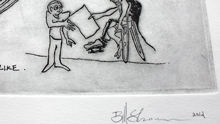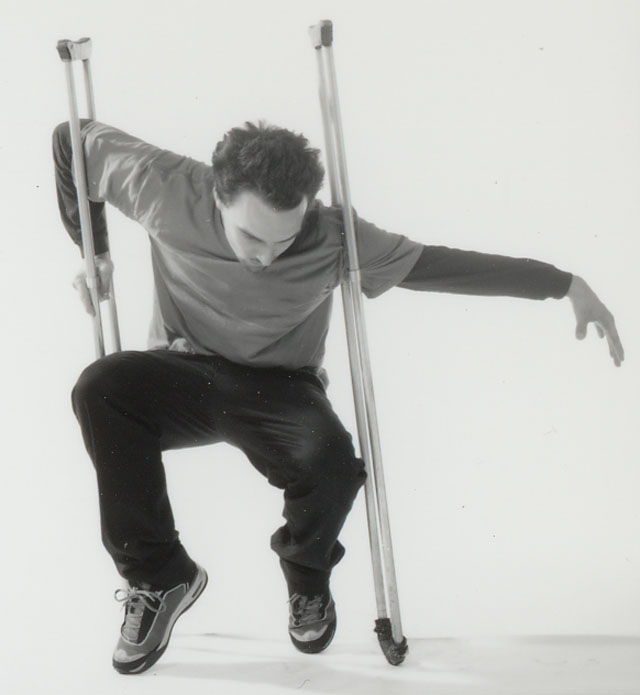TShirts, Stickers, Prints, Art Objects
WhatIsWhat 1.0 2003
A Brief Explanation of my Phenomenological Art
A significant portion of my work is about phenomenological events i bear witness to and am also highly sensitive to. The use of performance art as a real-time anthropological sociological tool to investigate define and categorize phenomena is at the core of this healing practice. My interactions with pedestrians and random individuals in public space is constantly evolving and changing over the course of time and my increased level of experience. This reality of being in public is a balancing act between getting on with my life and exploring new territories of my art. They serve each other and are therefore one and the same in many instances.
ABOVE: Shannon Technique, Hi-Mid Lo-Mid Split Photo: Dawn Blackman
It is very important for me to share that the relationship I have with an individual in public is often, though not always, in service to a long standing relationship I have with a given phenomena that the individual might embody. In other words, while I may be interacting with “Fred,” Fred’s behavior fits into pre-existing phenomenological patterns that I have interacted with many times in the past, labeled and developed strategies for. This is important to take into consideration because I want to be clear that Fred is not a victim that I am tricking, he is not being used for my own entertainment. Fred represents the cumulative presence of a phenomena that I am forced to engage in public space whether I choose to or not. Fred is approaching me everywhere I go everyday even though he might know himself as the only one in the moment he inhabits. I imagine that for Fred, its me and Fred, and I know that for me its me and Fred and Fred as Phenomena beyond Fred. I respect Fred but I cannot relate to Fred as Fred if he falls into the many patterns strangers tend to inhabit in relation to my public presence. This is my life and my art, not an episode of Jackass and a video camera. This is a critical differentiation necessary for me to spell out. Do not mistake my work for setups, tricks, pranks or clowning. In my work I have developed a Jackassification strategy where I take my work into Jackass territory to experience the difference between what I do and what Jackass is. This is the only way I have engaged in what I consider to be gratuitous albeit at times hilarious pranks. This strategy evolved out of my need to defend my practice from being lumped into a trickster shtick pigeonhole.
A “sociological phenomena” is the behavior a stranger or acquaintance might exhibit in relation to my presence that is shared by a cumulative mass of strangers over separate times and places. Thus a “sociological phenomena” exists outside of the actions of a given individual and are consistent across multiple individuals and multiple contexts. Many people from all walks of life experience stereotypes projected upon them in a public context. The difference in my opinion between reactions to my ambiguous and wide ranging representation of disability and the stereotypes other people endure related to their ability, age, race, class, culture, gender, and sexual orientation is the ease at which people will communicate with me directly and indirectly about the details of my life and identity and the cumulative volume of communication about these details over my lifetime.
Generally, we hide our fears hopes and assumptions about others because we don’t want to impose or be rude.
( I have deleted a passage here that described other characters one might encounter in the street but not be inclined ask them "what happened to you" The descriptions were in poor taste and published without care - sincerest apologies )
The difference with my disability is treated as a temporary trauma, my use of a skateboard is looked upon as an invitation to point and laugh and my medical details are open for pointed questions and ultimately expected to be validated on some level before I am accepted as “real.” Though I have a significant internal deformity which impairs my ability to walk, run, lift or carry, sit, stand or sleep it is not readily apparent to the naked eye. Because I can sit stand walk lift and carry in limited ways the limitations are not as apparent as the possibilities inherent in emplying modified rocker bottom crutches and a skateboard to walk. What I do looks fun and carefree and people react to that by throwing out all sort s of carefree questions that they consider fun and weightless such as “What happened to you?” Of course for me the weight of this question is staggering because it is asked so often in the day by so many different folks from different walks of life that if I took the time to explain what happened I would lose my days to what ultimately is a droll run down of the details. So for the individual it is light weight and fun to engage me whereas I have to negotiate this as dealing with not the individual but with THE PHENOMENA OF THE REPEATED QUESTION.
All this to say, while I am not unique to experience peoples stereotyping in public, I am in the unique situation to experience all degree of direct communication about it. It is within this range of volunteered interactions with strangers that my practice of realtime sociological anthropology was born.
A “strategy” is a specific behavior, sequence of actions, or verbal statements I engage in which are applied to specific phenomena. A “strategy” is a tool to dissect, circumvent or otherwise control events within the realtime moment the phenomena manifests itself.
“sociological anthropology” is the act of performing in real time with the intent of uncovering the details of the actions of individuals in the context of a greater phenomena. Its as if the process of discovery were akin to digging up an old bone. The location, the delicateness of the extraction process and the experience and relevance to previous specimens all come to bear on the quality of the results of a given phenomenological exploration.
To be “subject to a phenomena” is to experience some interaction with strangers in public repeatedly yet not have a definition of it or a “strategy” to control it.
To be “host to a phenomena” is to no longer be subject to a phenomena. When one hosts a phenomena they define it and can thereby develop strategies to explore the boundaries of it and ultimately control it.
In my next entry regarding phenomenology I will list all of my identified phenomena and strategies.
i also plan on defining all of my terms.
Terms are invented names to identify heretofore undefined acts that are not strategies or phenomena. For example, Disability Based Utilitariansim is a term that refers to how doing simple utilitarian acts such as opening a door when based in the possiblities and limitations of a given physical disability can appear radically different from the standard able bodied utilitarian act with the same goal as its end point. Identifying Disability Based Utilitarianism as a category of movements helpd me share with others the history and sources of my movements. To define a history is to cement it in place. Thus language becomes one of the most important tools of my dance.

This Work, A Brief Explanation of my Phenomenological Art, by Bill Shannon is licensed under a CC BY-NC-SA license.

